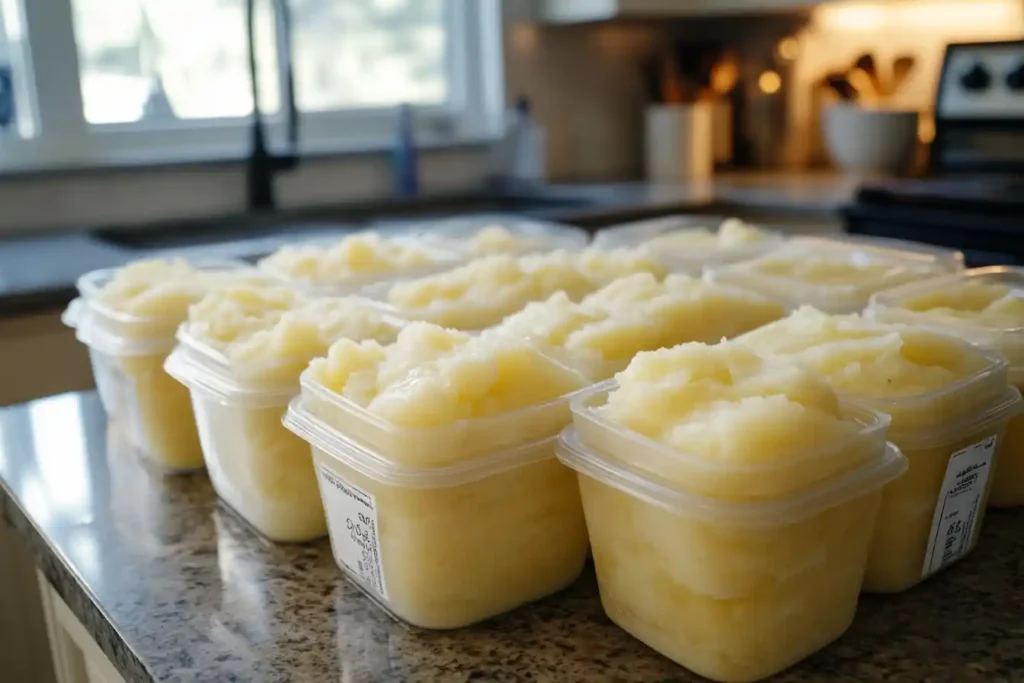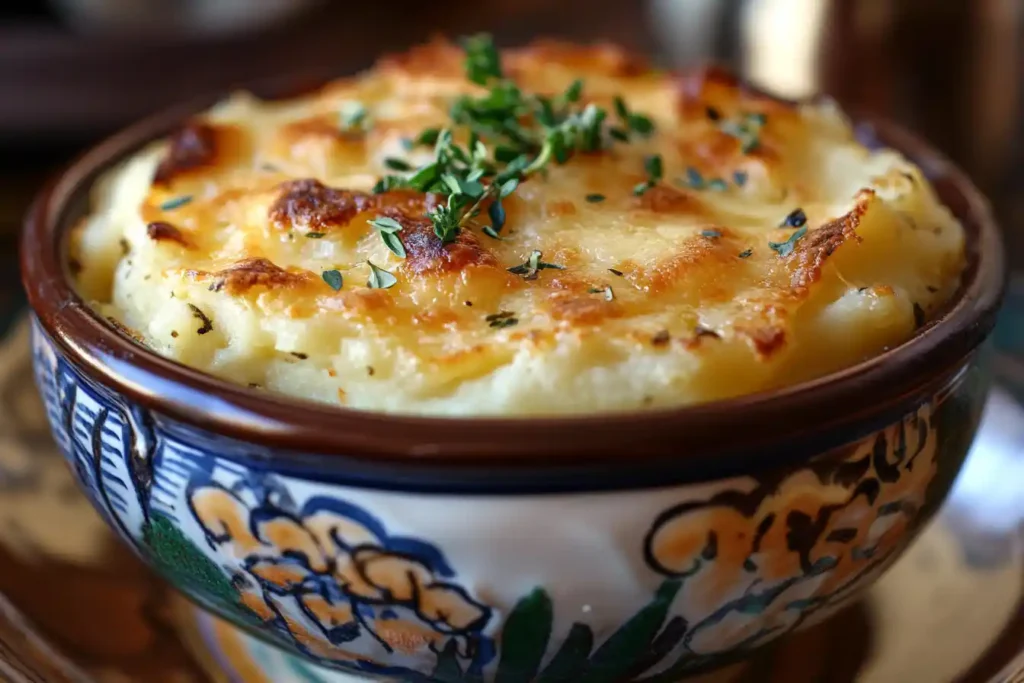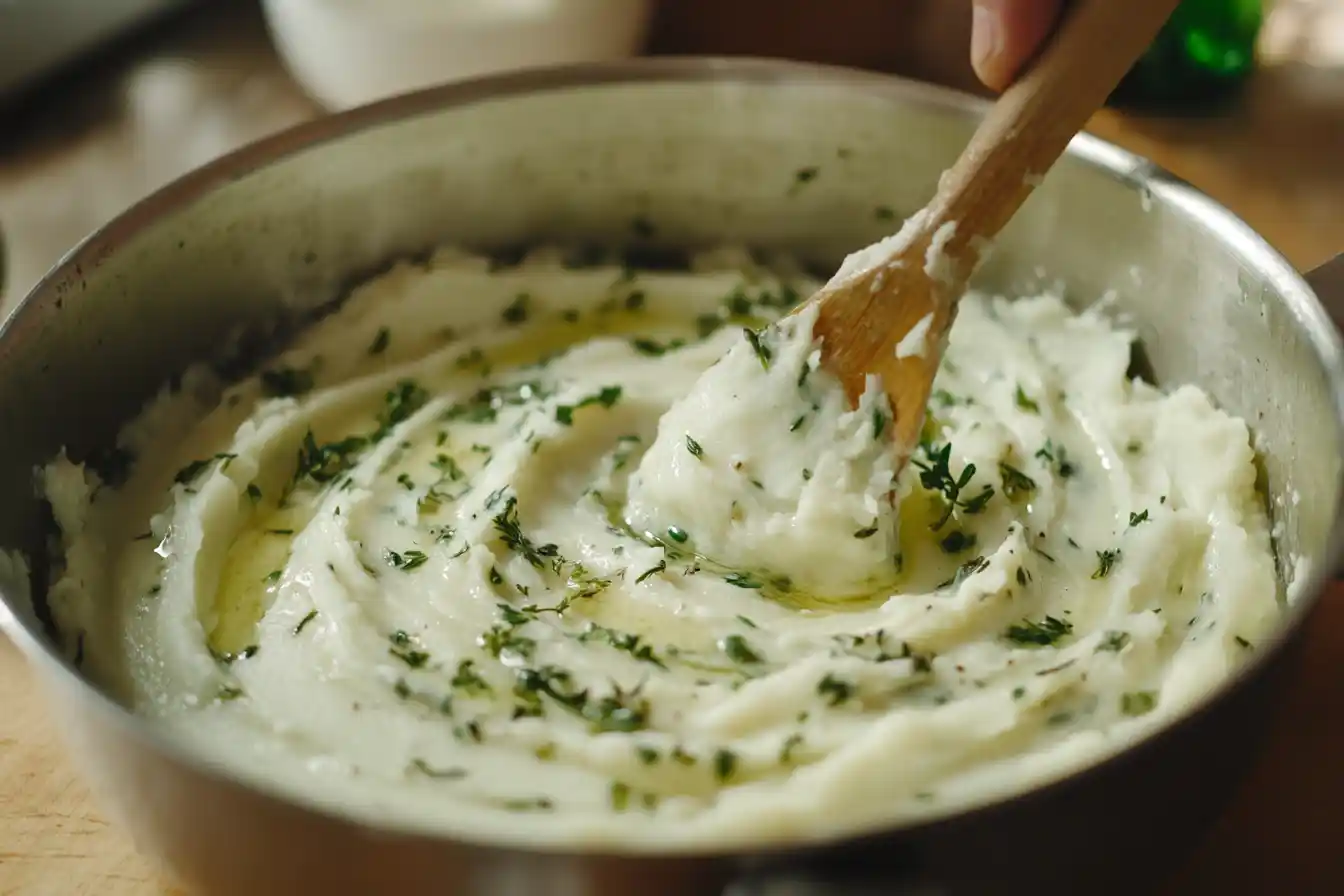Introduction
Mashed potatoes are a staple comfort food, loved for their creamy texture and rich flavor. But what happens when you’ve made too much and decide to freeze the leftovers? Freezing mashed potatoes is an excellent way to avoid waste, ensuring you always have a quick and satisfying side dish on hand. However, reheating them improperly can lead to dryness, lumps, or loss of flavor.
So, what is the best way to reheat frozen mashed potatoes? In this guide, we’ll explore multiple reheating methods, including the microwave, oven, stovetop, and slow cooker, to help you revive frozen mashed potatoes to their original creamy consistency. Plus, we’ll share tips for enhancing flavor and avoiding common mistakes.
Whether you’re preparing a quick meal or entertaining guests, this article will ensure your reheated mashed potatoes taste just as delicious as when they were freshly made.
Why Freeze Mashed Potatoes?
Freezing mashed potatoes is a smart way to extend their shelf life and reduce food waste. Many people prepare large batches of mashed potatoes for holidays, family dinners, or meal prepping, and freezing the leftovers saves time and effort for future meals.
Benefits of Freezing Mashed Potatoes
- Longer Shelf Life: Properly frozen mashed potatoes can last up to 2-3 months without losing flavor or texture.
- Convenience: Having pre-made mashed potatoes in your freezer means a quick side dish is always available.
- Cost-Effective: Bulk preparation reduces cooking time and saves money on ingredients.
- Meal Prep Friendly: Freezing portions makes it easier to plan meals ahead of time, especially for busy schedules.
Tips for Freezing Mashed Potatoes
- Use Full-Fat Ingredients: Mashed potatoes made with butter, cream, or milk freeze better than those made with skim milk or water. The fat content prevents ice crystals from forming, preserving the creamy texture.
- Portion Before Freezing: Divide the mashed potatoes into smaller, meal-sized portions to make reheating easier and faster.
- Seal Properly: Store mashed potatoes in airtight containers or freezer bags to prevent freezer burn and moisture loss.
- Label the Containers: Always label your containers with the date to keep track of how long they’ve been stored.
Preparing Frozen Mashed Potatoes for Reheating

Before jumping into reheating methods, preparation is key to maintaining flavor and texture.
Thawing Techniques
While it’s possible to reheat frozen mashed potatoes directly, thawing them first can lead to more even heating. Here are some effective thawing methods:
- Refrigerator Thawing:
- Transfer frozen mashed potatoes to the refrigerator and allow them to thaw overnight.
- This slow thawing method helps retain moisture and prevents a watery texture.
- Cold Water Bath:
- Place the frozen mashed potatoes in a sealed plastic bag.
- Submerge the bag in a bowl of cold water, changing the water every 30 minutes until the potatoes soften.
- Skip Thawing:
- If you’re short on time, you can reheat mashed potatoes directly from frozen, but you’ll need to stir frequently to prevent uneven heating.
Preserving Flavor and Texture
- Add Moisture: Frozen mashed potatoes may lose some moisture during storage. Add a splash of milk, cream, or melted butter to revive their creamy consistency while reheating.
- Season Again: Taste the potatoes after reheating and adjust the seasoning, as freezing can dull flavors.
Best Methods to Reheat Frozen Mashed Potatoes
Reheating frozen mashed potatoes properly is essential to maintain their creamy texture and rich flavor. Whether you’re in a hurry or preparing for a big meal, there’s a method to fit your needs. Let’s explore the four best ways to reheat frozen mashed potatoes.
1. Microwave Method (Quick and Easy)
The microwave is the fastest and easiest way to reheat frozen mashed potatoes, making it perfect for busy schedules.
Steps:
Place the frozen mashed potatoes in a microwave-safe bowl and cover them loosely with a lid or plastic wrap to trap moisture. Microwave on 50% power for 2–3 minutes at a time, stirring thoroughly after each interval. Add milk, butter, or cream as needed to restore moisture and creaminess. Repeat until the mashed potatoes are heated evenly.
Pros:
- Fast and convenient for small portions.
- Minimal cleanup required.
Cons:
- May lead to uneven heating if not stirred properly.
- Requires close monitoring to prevent drying out.
2. Oven Method (Slow and Even Heating)
The oven is an excellent option for reheating large portions of mashed potatoes, especially for family gatherings.
Steps:
Preheat the oven to 350°F (175°C). Transfer the frozen mashed potatoes to an oven-safe dish and cover tightly with aluminum foil to retain moisture. Bake for 30–40 minutes, stirring halfway through and adding milk or butter if needed. Remove the foil during the last 5 minutes for a slightly golden top if desired.
Pros:
- Great for large batches.
- Even heating without constant supervision.
Cons:
- Takes longer than other methods.
- Requires preheating the oven.
3. Stovetop Method (Rich and Creamy Results)
For those who prefer a hands-on approach, reheating mashed potatoes on the stovetop provides excellent control over texture.
Steps:
Place the frozen mashed potatoes in a saucepan over low to medium heat. Stir constantly to prevent sticking and burning. Gradually add milk, cream, or butter to loosen the consistency as the potatoes heat. Stir vigorously to achieve a smooth and creamy texture.
Pros:
- Produces rich, creamy mashed potatoes.
- Allows adjustments during the reheating process.
Cons:
- Requires constant attention and stirring.
- Not ideal for large portions.
4. Slow Cooker Method (Hands-Off Convenience)
The slow cooker is a hassle-free option, especially when you need to reheat mashed potatoes while focusing on other dishes.
Steps:
Place the frozen mashed potatoes in the slow cooker and set it to low heat. Add a bit of milk or butter and stir occasionally. Allow the potatoes to heat slowly for 2–3 hours until they’re fully warmed through. Stir well before serving.
Pros:
- Hands-off method with minimal effort.
- Ideal for reheating large quantities for parties or gatherings.
Cons:
- Takes longer than other methods.
- May require stirring periodically to prevent uneven heating.
Reheating Tips for Perfect Mashed Potatoes
Reheating frozen mashed potatoes can be tricky, but with a few simple tips, you can restore their original creamy and fluffy texture. Here are the best practices to ensure your reheated mashed potatoes taste just as good as freshly made ones.
1. Add Moisture While Reheating
Frozen mashed potatoes often lose moisture during storage, making them prone to dryness when reheated. To fix this, stir in small amounts of milk, heavy cream, or melted butter while reheating. Start with 1–2 tablespoons at a time and add more as needed until the desired consistency is reached. This step helps to recreate the creamy texture without making them watery.
2. Stir Frequently for Even Heating
Mashed potatoes tend to heat unevenly, especially in the microwave. Stir them frequently during reheating to prevent hot spots and ensure uniform warmth throughout. Use a rubber spatula or wooden spoon to gently fold the potatoes instead of mashing further, preserving their fluffiness.
3. Adjust Seasoning After Reheating
Freezing can sometimes dull the flavors of mashed potatoes. After reheating, taste them and adjust the seasoning as needed. Add a pinch of salt, pepper, garlic powder, or onion powder to enhance flavor. You can also mix in a sprinkle of parmesan cheese or fresh herbs like chives or parsley for added depth.
4. Avoid Overheating
Overheating mashed potatoes can cause them to dry out or develop a gluey texture due to over-stirring. To prevent this, reheat over low to medium heat and keep a close eye on them. Remove from heat as soon as they are hot but not steaming, and stir one last time before serving.
5. Use Stock or Broth for Extra Flavor
For added richness, consider replacing milk with chicken or vegetable broth while reheating. This trick works especially well for savory mashed potatoes, giving them a deeper flavor profile without overwhelming their taste.
Common Mistakes to Avoid
Even the most experienced cooks can make mistakes when reheating frozen mashed potatoes. Here are some of the most common errors to watch out for:
1. Skipping the Thawing Step
While it’s possible to reheat mashed potatoes directly from frozen, skipping the thawing process can lead to uneven heating. Taking the time to thaw them in the refrigerator overnight or using a cold water bath helps preserve their texture.
2. Not Adding Moisture
Frozen mashed potatoes tend to lose moisture, and reheating them without adding liquid can make them dry and crumbly. Always incorporate milk, cream, butter, or broth to restore their smooth consistency.
3. Overheating the Potatoes
Overheating mashed potatoes, especially in the microwave, can cause the starch to break down, resulting in a gluey texture. Reheat slowly and stir frequently to maintain their fluffiness.
4. Using High Heat
Reheating mashed potatoes over high heat can burn the bottom and leave the top cold. Instead, opt for low to medium heat on the stovetop or 350°F in the oven for even warming.
5. Over-Stirring
While stirring is necessary for even heating, over-stirring can make mashed potatoes gummy. Use a gentle folding motion and avoid excessive mashing during reheating.
Enhancing Reheated Mashed Potatoes

Reheated mashed potatoes don’t have to be plain—there are plenty of ways to elevate their flavor and texture. With just a few extra ingredients and techniques, you can turn ordinary mashed potatoes into a gourmet side dish.
1. Add Cheese for a Rich Flavor
Mixing in shredded cheese can make reheated mashed potatoes extra indulgent. Cheddar, Parmesan, Gruyère, or mozzarella are great options. Simply stir in the cheese while reheating until it melts and blends smoothly. For an even richer flavor, sprinkle grated cheese on top and broil for a golden, bubbly finish.
2. Infuse with Garlic or Herbs
For a savory twist, stir in roasted garlic, garlic powder, or garlic paste. Fresh or dried herbs like parsley, chives, thyme, or rosemary also add layers of flavor. These simple additions make mashed potatoes more aromatic and flavorful.
3. Make Them Creamier
To achieve an ultra-creamy texture, mix in a dollop of sour cream, cream cheese, or Greek yogurt. These ingredients add tanginess while boosting creaminess. If you prefer a lighter texture, try whipping in a bit of evaporated milk or buttermilk.
4. Spice It Up
For those who like bold flavors, a pinch of spices can make a big difference. Smoked paprika, cayenne pepper, or nutmeg can give reheated mashed potatoes a subtle kick. Just be sure to add spices gradually and taste as you go.
5. Transform Leftovers into New Dishes
Leftover mashed potatoes can also be repurposed into entirely new meals. Some creative ideas include:
- Mashed Potato Pancakes: Combine with egg, flour, and cheese, then fry until golden brown.
- Shepherd’s Pie: Use as a topping for a savory meat and vegetable filling.
- Potato Croquettes: Shape mashed potatoes into balls, coat with breadcrumbs, and fry until crispy.
- Loaded Potato Casserole: Mix with bacon, cheese, and green onions, then bake until bubbly.
- Soup Thickener: Stir them into soups and stews for added creaminess and flavor.
How Long Does Reheated Mashed Potatoes Last?
Once reheated, mashed potatoes need to be stored properly to avoid spoilage. Here’s what you need to know:
Storage Guidelines for Reheated Mashed Potatoes
- Refrigeration: Store any leftovers in an airtight container and refrigerate within 2 hours of reheating. Properly stored mashed potatoes can last for 3–4 days in the fridge.
- Freezing Again: Reheating mashed potatoes multiple times can affect texture. It’s best not to freeze them again after reheating. Instead, use any leftovers in other recipes to avoid waste.
- Labeling: Always label containers with the reheating date to track freshness.
Safety Tips to Prevent Spoilage
- Avoid leaving reheated mashed potatoes at room temperature for more than 2 hours.
- Reheat only the portion you plan to eat to minimize repeated heating.
- Discard mashed potatoes that smell off, taste sour, or show signs of mold.
FAQs About Reheating Frozen Mashed Potatoes
1. Can You Reheat Mashed Potatoes Without Thawing?
Yes, you can reheat mashed potatoes directly from frozen, but it may take longer and require frequent stirring to ensure even heating. Adding liquid like milk or butter will help restore creaminess.
2. How Many Times Can You Reheat Mashed Potatoes?
For safety and quality, it’s best to reheat mashed potatoes only once. Repeated reheating can affect the texture and increase the risk of bacterial growth.
3. What is the Safest Temperature for Reheating Mashed Potatoes?
Reheated mashed potatoes should reach an internal temperature of 165°F (74°C) to ensure they’re safe to eat. Use a food thermometer to check.
4. Can You Reheat Mashed Potatoes in an Air Fryer?
Yes, mashed potatoes can be reheated in an air fryer. Place them in an oven-safe dish, cover with foil, and heat at 350°F (175°C) for about 10–15 minutes. Stir halfway through for even heating.
5. How Do You Fix Dry Mashed Potatoes?
Add a splash of milk, cream, or melted butter and stir thoroughly to restore moisture. If they’re still too thick, add a little chicken or vegetable broth for extra flavor.
6. Can You Make Mashed Potatoes Creamy Again After Reheating?
Yes, reheated mashed potatoes can regain their creaminess by adding a bit of cream cheese, sour cream, or melted butter and stirring well. Whisking with an electric mixer can also help fluff them up.
Conclusion
Reheating frozen mashed potatoes doesn’t have to be a challenge if you follow the right methods and tips. Whether you choose the quick microwave method, the slow and even oven approach, the stovetop technique for creamy results, or the hands-off slow cooker option, there’s a reheating method that suits your needs.
The key to success lies in adding moisture, stirring frequently, and seasoning after reheating to bring back the flavor and texture you love. Avoid common mistakes like overheating or skipping thawing to ensure your mashed potatoes remain soft and creamy.
Don’t forget to experiment with enhancements such as cheese, garlic, and herbs to make your mashed potatoes even more delicious. If you have leftovers, repurpose them into exciting dishes like potato pancakes or casseroles to reduce food waste.
By following these steps, you’ll always have mashed potatoes that taste as good as they did when first made—smooth, flavorful, and comforting. So, the next time you freeze your mashed potatoes, rest assured that reheating them to perfection is just a few simple steps away.
For more tips on handling frozen mashed potatoes, check out Are Mashed Potatoes Good After Being Frozen? to learn about storage and quality. Also, explore Is Frozen Mashed Potato Any Good? for preparation ideas. If you’re cooking from frozen, don’t miss What Is the Best Way to Cook Frozen Mashed Potatoes?.

